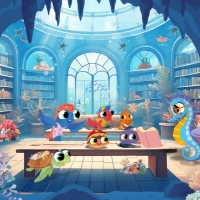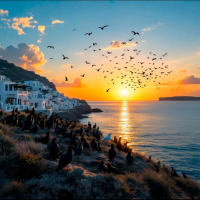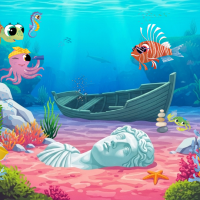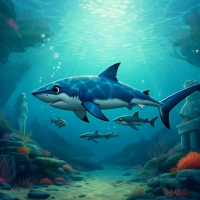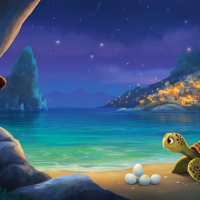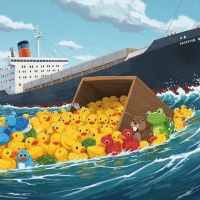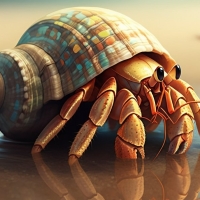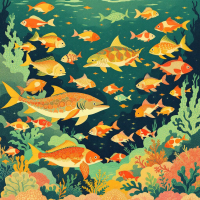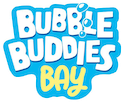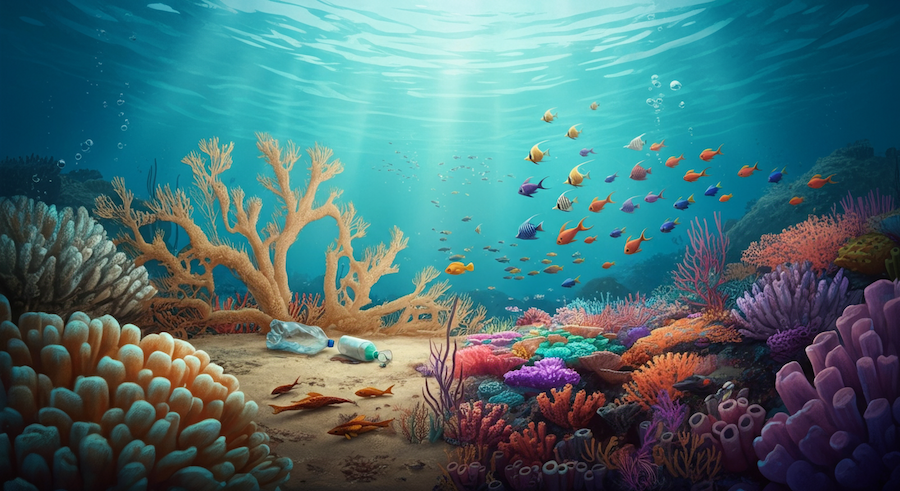
Underwater Cities: Coral Reefs and Their Secrets
Hello, my fin-tastic explorers! Today, we are diving into the incredible world of coral reefs, the ocean’s underwater cities! There is so much to discover, and I have lots of exciting and important things to share with you. It might be a little long, but I promise it's worth the journey!
What is Coral? What is a Reef?
Coral reefs are often referred to as the "rainforests of the sea," and for good reason.
Rainforests are full of animals and plants on land, just like coral reefs are full of life in the sea! Tiny clownfish hide in the stinging tentacles of anemones, while graceful manta rays glide through the water.
These fish are like puzzle pieces in the reef: they eat smaller creatures and are also food for bigger ones., and help everything fit together just right in the underwater food party!
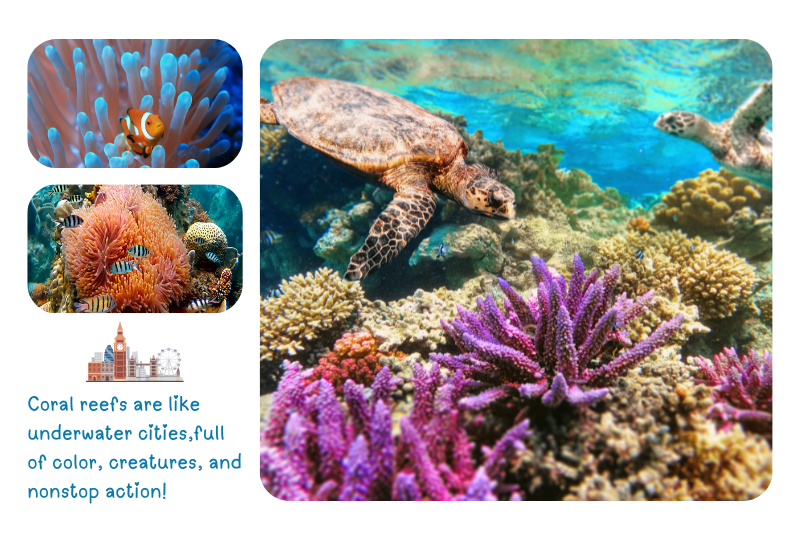
Coral itself is actually a tiny animal! Imagine hundreds or even thousands of little soft creatures called polyps living together. Each polyp is like a tiny blob with its own mouth and little stinging tentacles to catch food like plankton and small fish. They're related to jellyfish and sea anemones.
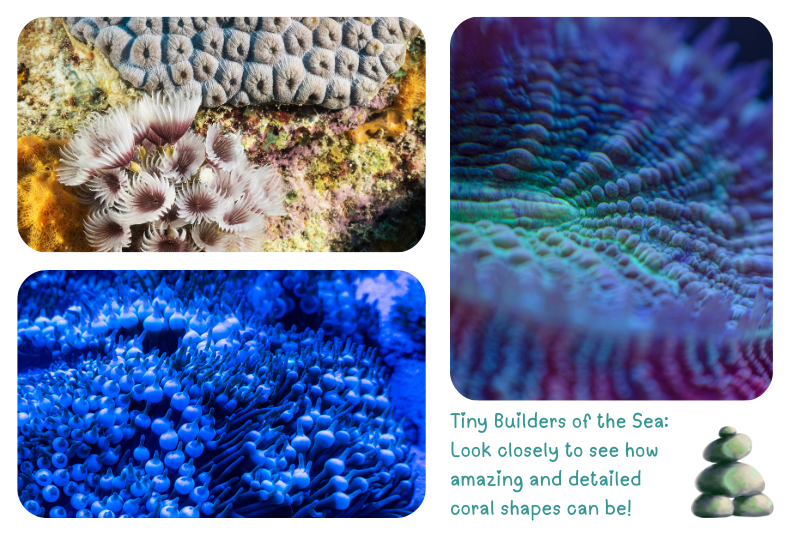
Hard corals are special because they build a strong shell under themselves to stay safe. It’s made of a chalky material, kind of like bricks! (It's called calcium carbonate).
This chalky house is their skeleton! Over many, many years (sometimes hundreds of years) these tiny polyps grow and multiply, building new layers on top of the old skeletons. It's like building a house floor by floor!
When you look at a coral colony, only the thin layer on the very top is alive; all the big mass underneath is the old, hard skeleton that might be decades old!
Imagine all those tiny polyps and their hard little houses growing slowly, slowly, building up the big, strong coral reef over many, many years!
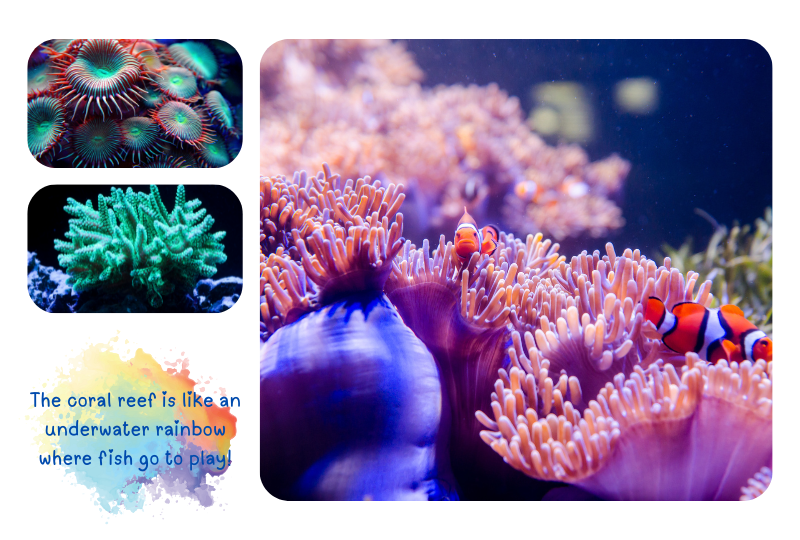
But not all corals are hard! There are also soft corals, like the sea fans. They are squishy and bendy, often looking like trees or fans, and they don't build hard skeletons.
Then there are also hydrocorals, also called fire coral, which have hard skeletons but also stinging cells that can feel like a burn if you touch them!
A reef is just any bumpy place on the ocean floor that sticks up. It could be something natural, like a small hill made of rock, or unfortunately something made by humans, like a pile of old car tires (I really don't like that!) or an old sunken boats.
A coral reef is when that bumpy structure is mostly built by the little hard coral animals! So, a coral reef will always be a reef, but not every reef is a coral reef!
Sunshine Lovers and Deep-Sea Dwellers
Most of the colourful corals you see in sunny, shallow water need help from tiny, plant-like friends called zooxanthellae (can you pronounce it? Try: zoo-zan-THEL-ee). These microscopic algae live right inside the coral polyps' tissues. It's a special friendship where both benefit:
- The coral gives the zooxanthellae a safe, protected home and the things they need.
- In return, these little algae use sunlight to make food (this is called photosynthesis!), and they share almost all of that food (about 80% to 90%!) with the coral, giving it energy to grow.
- Zooxanthellae also help the coral get rid of waste and give the coral its beautiful colours, because coral polyps themselves are actually clear!
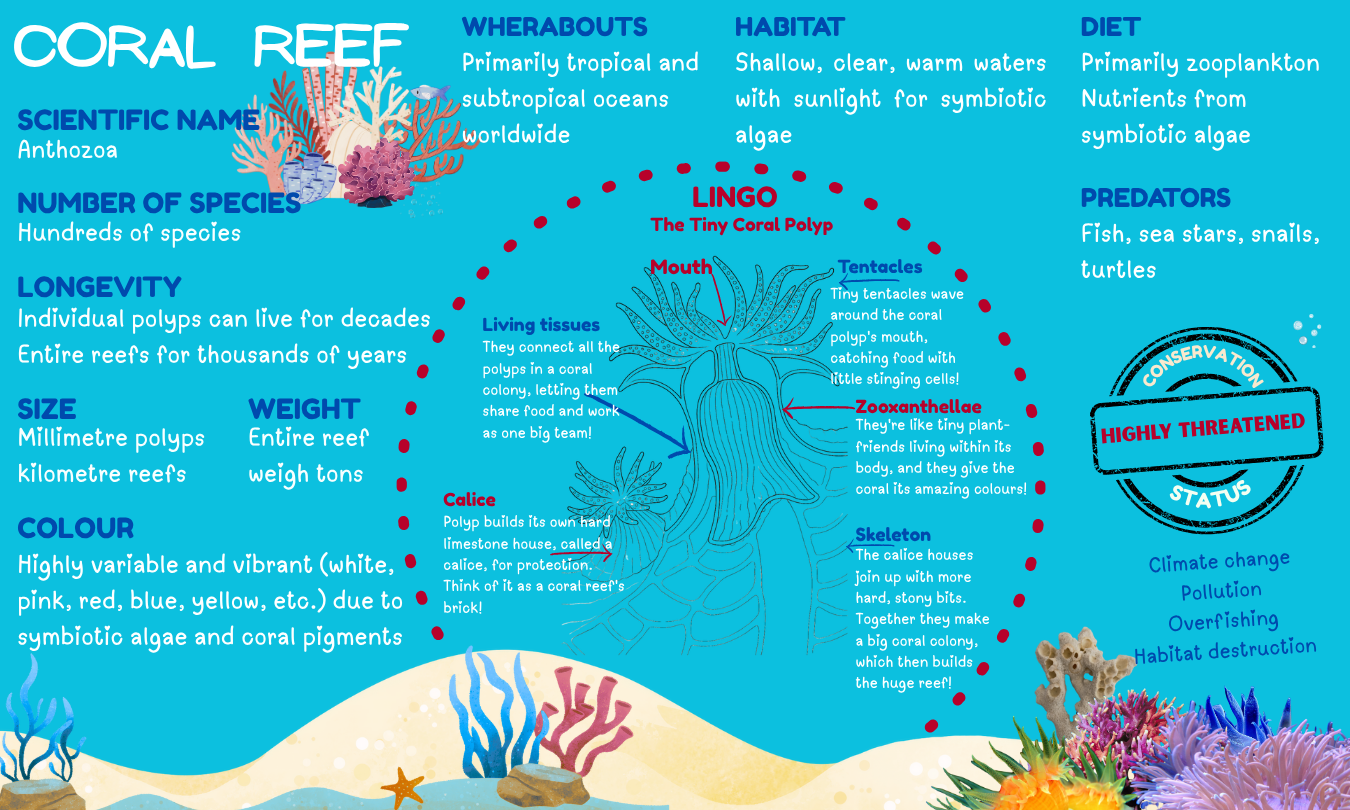
These corals need sun and very clear, salty water and usually live in warm, shallow, tropical and subtropical oceans, mostly between 30 degrees north and 30 degrees south of the equator. Think of places like the Red Sea, the Indian Ocean, the Pacific Ocean, the Caribbean, and around Florida.
But some corals live way down deep in the ocean where it's much colder and dark! These deep-sea corals don't need sunlight because they don't have those little plant friends. Instead, they catch plankton and other tiny bits of organic matter floating by for their energy.
The World’s Reefs: Different Oceans, Same Magic
The largest coral reef in the world is Australia’s Great Barrier Reef, which is incredibly long, over 1,400 kilometres! It's home to thousands of different species, including over 1,500 types of fish, 400 species of coral, sea turtles, sea snakes, rays, and even dugongs (look them up, they are cute). This reef is a living wonder and a World Heritage Site.
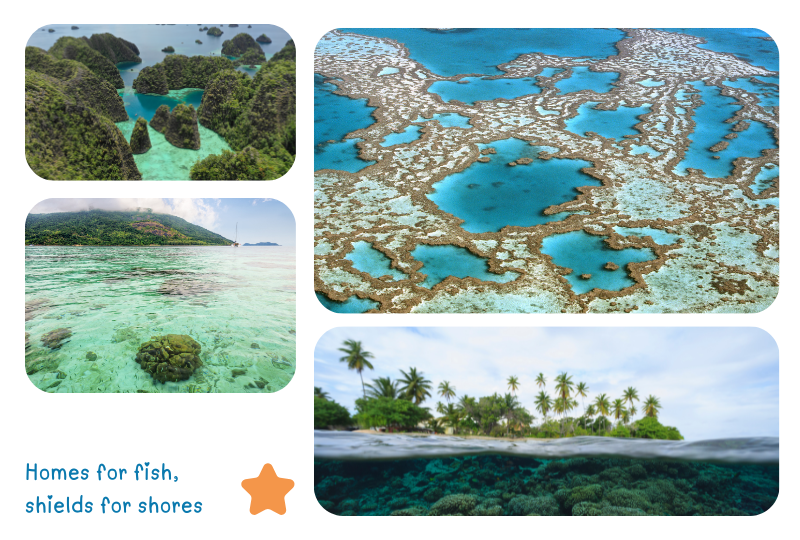
The second-largest reef system in the world is called the Mesoamerican Barrier Reef, and it stretches along the coasts of Mexico, Belize, Guatemala, and Honduras. It may not be quite as big as Australia’s reef, but it's just as magical! This reef is home to endangered species like the manatee and the hawksbill sea turtle, and it's a super important nursery for baby fish that live in mangroves and seagrass beds nearby.
Here in the Mediterranean Sea, we have coral reefs too! They might not have the huge, shallow, brightly coloured reefs like the Great Barrier Reef or the Caribbean, but they are still beautiful and full of diverse coral ecosystems! We have some unique corals, that grow much slower than tropical ones, sometimes just a few millimetres a year, and can live for hundreds of years, like the Red Gorgonian.
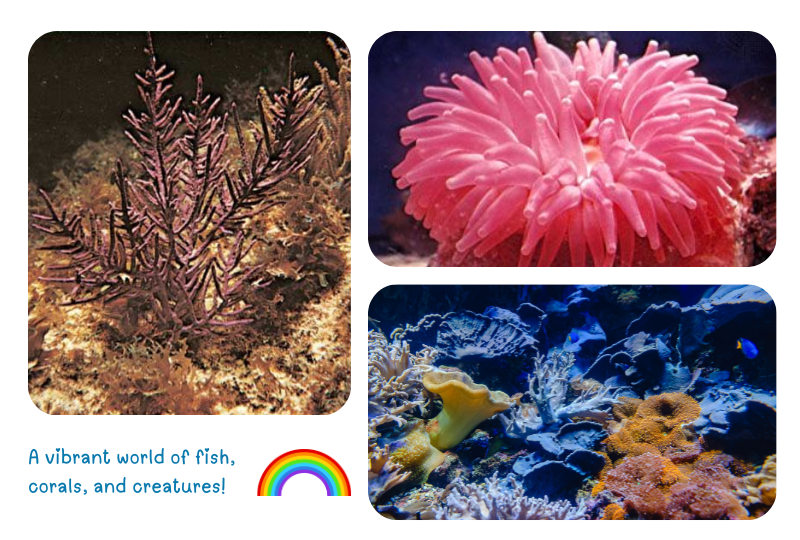
Why are Coral Reefs so Important?
Coral reefs do so many important things for our planet and for us!
- Coastal Protectors: They act like giant underwater walls, protecting our coasts from big storms, powerful waves, and erosion. When coral reefs are damaged, we see more flooding and erosion, which hurts coastal communities.
- Homes for Everyone: They are bustling cities underwater, providing habitat for thousands of species! This includes tiny organisms like bacteria, all sorts of fish and even sea turtles! They are also connected to nearby seagrass and mangrove areas. They really are a centre of activity for marine life.
- Food and Jobs: Over half a billion people around the world depend on reefs for their food and for jobs. These are super important ecosystems, especially for people living in island nations.
- New Medicines: Scientists are exploring corals as a source for new medicines! They've found chemicals from corals that can be used to make powerful antibiotics, or fight tough bacteria that other medicines can't.
- Cultural Importance: These ecosystems are also incredibly important culturally to many local people all over the world.
Dangers and How We Can Help
Sadly, coral reef ecosystems around the world are severely threatened. Some problems are natural, like diseases, predators, or big storms, but many threats are caused by people.
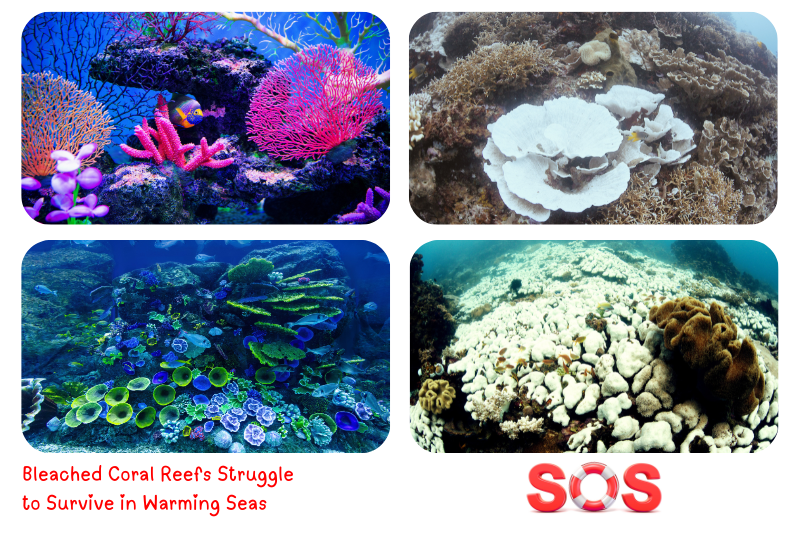
- Pollution & Sedimentation: When too much dirt or pollution goes into the ocean, it can smother corals or block the sunlight they need
- Unsustainable Fishing: This is a huge problem. Overfishing means catching more fish than the ocean can replace, and destructive fishing uses things like explosives or poison to kill fish.
These methods destroy corals and make it very hard for the reef to heal.
About half of the world's coral reef species are endangered because of these fishing practices. - Climate Change: This is a big one! It’s making the ocean water warmer and causing something called ocean acidification — whoa, I know, that’s a weird word! Let me explain:
When people burn too much fuel (like from cars or factories or fires), it puts a gas called carbon dioxide into the air. Some of that gas gets soaked up by the ocean, and it makes the water a little more sour, kind of like lemon juice! That sourness makes it harder for sea animals like corals and snails to grow their strong, hard shells.
All this stress can lead to coral bleaching. That’s when corals get so upset they kick out their tiny plant friends (remember zooxanthellae?) who usually help feed them. Without their plant pals, the corals turn white and can get really sick… and sometimes, they don’t survive
-
Invasive Species: Here's a tricky problem: sometimes, animals move to new ocean homes where they don't belong. With no enemies there, they grow too many and make it hard for our usual neighbours to live!
- Life in a Glass Box: Another worry is when lovely fish and corals are taken from the wild to live in glass tanks. Millions are taken each year. Sometimes, harmful sprays are used to catch them, and many don't even survive the long trip. We much prefer our big, blue ocean home!
- Visitors and Our Coral Homes: Tourism brings people to our beautiful ocean, which is nice. But sometimes, if we're not careful, it can harm our home.
Divers might accidentally touch or break our delicate corals.
Boats can drop anchors right onto our reef homes.
And dirty water from hotels can make the sea cloudy, helping yucky algae grow, which hurts our coral friends.
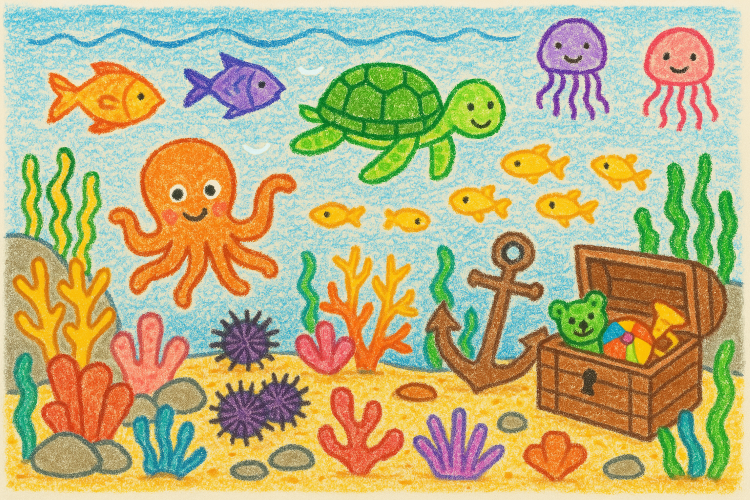
The good news is that if conditions improve before they die, corals can sometimes recover from bleaching, though it can take many years for the ecosystems to fully heal.
Scientists are also working hard to help. They are testing new ways, like growing baby corals in special "nurseries" and then planting them back onto damaged areas of the reef.
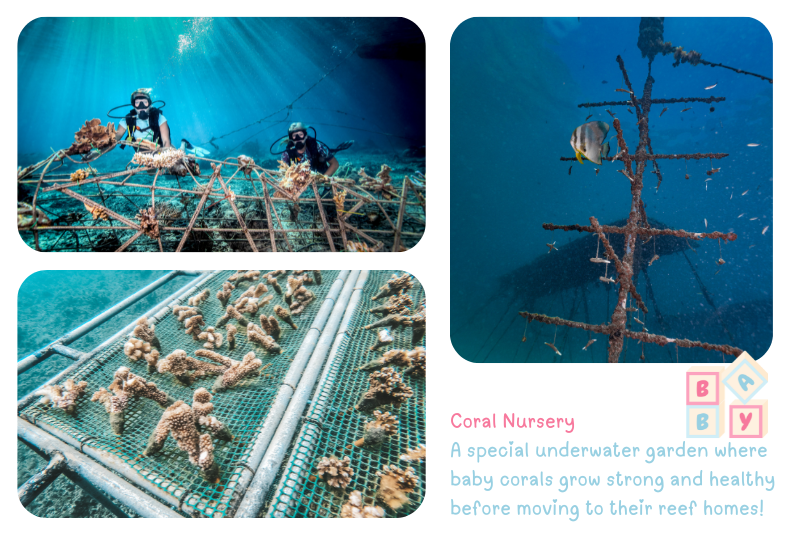
Coral reefs are a vital part of our ocean. They are crucial for all marine life and for people too. That’s why we all need to work together to protect these beautiful underwater cities, before it’s too late!
What can we do?
Grownups can help by making national parks underwater and controlling things like overfishing, pollution, and climate change.
And you?
- Learn and Share: Understanding what coral reefs are and why they are important is the first step. Talk about them with your family, friends, or class. When more people care, more people help!
- Keep It Clean: Always pick up litter, even if you're far from the sea. rubbish can travel through drains and rivers into the ocean. Never throw anything into the water or on the ground.
- Save Water: Use less water at home. Turn off the tap when brushing your teeth. Less water waste means less pollution flowing into the sea.
- Be a Smart Shopper: Ask your family not to buy coral jewellery or souvenirs made from shells, sea stars, or dried marine animals. Choose items that do not harm ocean life.
- Use Reef-Safe Sunscreen: Some sunscreens harm corals. Look for reef-safe or mineral-based sunscreens with zinc oxide or titanium dioxide.
Here are some fun activities for you to learn more:
🪸 Colour my reef: This is a drawing of me and my besties exploring a beautiful coral reef! I totally forgot to add the colours (how silly is that for a coral reef!?) Can you help bring it to life?
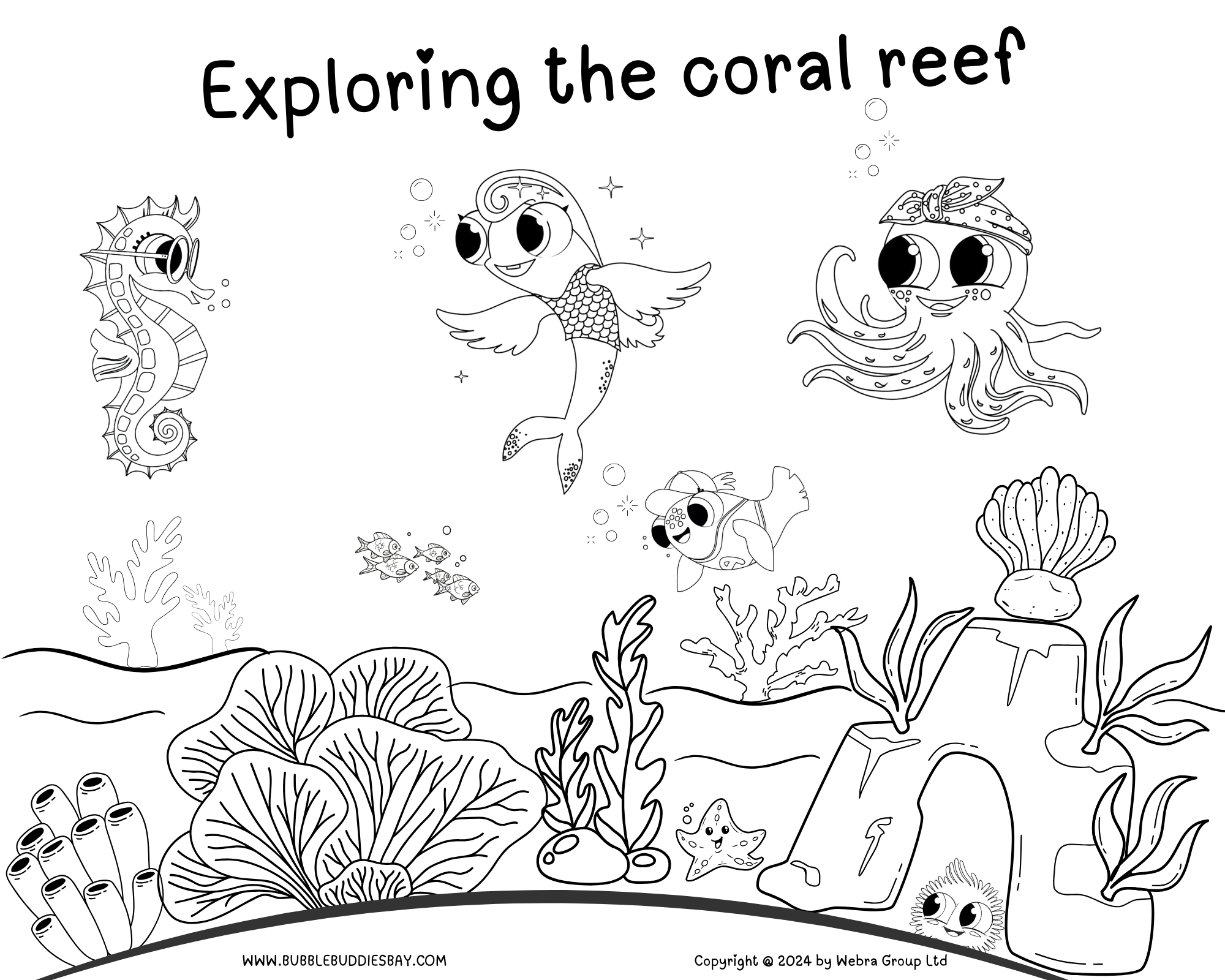
🪸 Watch a Coral Reef Documentary: For quiet time, watch a child-friendly reef documentary like BBC Blue Planet (reef episodes) Octonauts (coral and ocean episodes). Then draw or talk about what you saw.
🪸 Ocean Cleaner-Upper Sort!
What you need: A basket or box, different types of clean "rubbish" (like an empty plastic bottle, a clean milk carton, a piece of fabric, a paper scrap). Two other baskets labelled "Recycle" and "Rubbish."
How to play: Spread the "rubbish" around the room. Pretend you're a little clean-up crew in the ocean! Pick up each item and decide if it goes in the "Recycle" bin or the "rubbish" bin to keep the ocean healthy.
🪸 Coral Polyp Dance!
What you need: Just yourselves! Maybe some calming music.
How to play: Pretend you are a coral polyp! Stand tall, then slowly sway your arms like tentacles reaching for tiny food in the water. You can open and close your hands like polyps eating! Then, slowly and gently, pretend to build your hard little house by stiffening your body a tiny bit.
Don’t forget, the ocean is our big blue backyard!
Sophia the Seahorse

